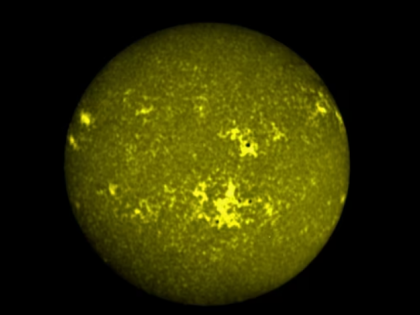ISRO's Aditya-L1 captures full-disk images of Sun in near ultraviolet wavelengths
By Lokmat English Desk | Published: December 9, 2023 05:06 PM2023-12-09T17:06:01+5:302023-12-09T17:08:45+5:30
The Solar Ultraviolet Imaging Telescope (SUIT) instrument on board the Aditya-L1 spacecraft has successfully captured the first full-disk images ...

ISRO's Aditya-L1 captures full-disk images of Sun in near ultraviolet wavelengths
The Solar Ultraviolet Imaging Telescope (SUIT) instrument on board the Aditya-L1 spacecraft has successfully captured the first full-disk images of the Sun in the 200-400 nm wavelength range. SUIT captured images of the Sun's photosphere and chromosphere in this wavelength range using various scientific filters.
"On November 20, 2023, the SUIT payload was powered ON. Following a successful pre-commissioning phase, the telescope captured its first light science images on December 6, 2023," an ISRO statement said on Friday.
"These unprecedented images, taken using eleven different filters, include the first-ever full-disk representations of the Sun in wavelengths ranging from 200 to 400 nm, excluding Ca II h. The full disk images of the Sun in the Ca II h wavelength have been studied from other observatories," it said.
Aditya-L1 Mission:
— ISRO (@isro) December 8, 2023
The SUIT payload captures full-disk images of the Sun in near ultraviolet wavelengths
The images include the first-ever full-disk representations of the Sun in wavelengths ranging from 200 to 400 nm.
They provide pioneering insights into the intricate details… pic.twitter.com/YBAYJ3YkUy
Among the notable features revealed are sunspots, plage, and quiet Sun regions, providing scientists with pioneering insights into the intricate details of the Sun's photosphere and chromosphere. SUIT observations will help scientists study the dynamic coupling of the magnetized solar atmosphere and assist them in placing tight constraints on the effects of solar radiation on Earth's climate, ISRO added.
View this post on Instagram
The development of SUIT involved a collaborative effort under the leadership of the Inter-University Centre for Astronomy and Astrophysics, Pune. This collaboration included ISRO, the Manipal Academy of Higher Education, the Centre for Excellence in Space Science India at IISER-Kolkata, the Indian Institute of Astrophysics Bengaluru, the Udaipur Solar Observatory (USO-PRL), and Tezpur University Assam, it was stated.
Aditya-L1 is the first Indian space-based observatory to study the Sun from a halo orbit around first Sun-earth Lagrangian point (L1), which is located roughly 1.5 million km from Earth. The Aditya-L1 spacecraft was launched on September 2 from the Satish Dhawan Space Centre, Sriharikota.
Open in app